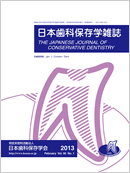Volume 51, Issue 6
Displaying 1-15 of 15 articles from this issue
- |<
- <
- 1
- >
- >|
Review
-
Article type: Review
2008 Volume 51 Issue 6 Pages 587-592
Published: December 31, 2008
Released on J-STAGE: March 30, 2018
Download PDF (1213K)
Mini Reviews
-
Article type: Mini Reviews
2008 Volume 51 Issue 6 Pages 593-595
Published: December 31, 2008
Released on J-STAGE: March 30, 2018
Download PDF (604K) -
Article type: Mini Reviews
2008 Volume 51 Issue 6 Pages 596-598
Published: December 31, 2008
Released on J-STAGE: March 30, 2018
Download PDF (437K) -
Article type: Mini Reviews
2008 Volume 51 Issue 6 Pages 599-601
Published: December 31, 2008
Released on J-STAGE: March 30, 2018
Download PDF (571K)
Original Articles
-
Article type: Original Articles
2008 Volume 51 Issue 6 Pages 602-613
Published: December 31, 2008
Released on J-STAGE: March 30, 2018
Download PDF (1467K) -
Article type: Original Articles
2008 Volume 51 Issue 6 Pages 614-621
Published: December 31, 2008
Released on J-STAGE: March 30, 2018
Download PDF (935K) -
Article type: Original Articles
2008 Volume 51 Issue 6 Pages 622-629
Published: December 31, 2008
Released on J-STAGE: March 30, 2018
Download PDF (949K) -
Article type: Original Articles
2008 Volume 51 Issue 6 Pages 630-638
Published: December 31, 2008
Released on J-STAGE: March 30, 2018
Download PDF (907K) -
Article type: Original Articles
2008 Volume 51 Issue 6 Pages 639-647
Published: December 31, 2008
Released on J-STAGE: March 30, 2018
Download PDF (882K) -
Article type: Original Articles
2008 Volume 51 Issue 6 Pages 648-658
Published: December 31, 2008
Released on J-STAGE: March 30, 2018
Download PDF (2070K) -
Article type: Original Articles
2008 Volume 51 Issue 6 Pages 659-669
Published: December 31, 2008
Released on J-STAGE: March 30, 2018
Download PDF (2714K) -
Article type: Original Articles
2008 Volume 51 Issue 6 Pages 670-680
Published: December 31, 2008
Released on J-STAGE: March 30, 2018
Download PDF (2594K) -
Article type: Original Articles
2008 Volume 51 Issue 6 Pages 681-692
Published: December 31, 2008
Released on J-STAGE: March 30, 2018
Download PDF (1581K) -
Article type: Original Articles
2008 Volume 51 Issue 6 Pages 693-699
Published: December 31, 2008
Released on J-STAGE: March 30, 2018
Download PDF (764K) -
Article type: Original Articles
2008 Volume 51 Issue 6 Pages 700-715
Published: December 31, 2008
Released on J-STAGE: March 30, 2018
Download PDF (2307K)
- |<
- <
- 1
- >
- >|
